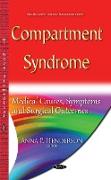Compartment Syndrome
BücherAngebote / Angebote:
There are various underlying causes which initiate the sequence of events resulting in compartment syndrome including fractures, bleeding, tightly applied casts or extrinsic compressions devices, burns or vigorous exercise. The first chapter of this book serves to review the current understanding of ACS's pathophysiology and highlight implications for the modernization of diagnosis and treatment. The second chapter reviews the evidence relevant to how anesthesiologists can influence the genesis of compartment syndrome. Anesthesia may influence the development of CS through the use of regional anesthesia, optimum blood pressure control and oxygen delivery, and tailored analgesia in the peri-operative period. It provides support for the best anesthesia practices in an effort to avoid this complication which may have serious adverse effects for the patient. The three essential components of conventional pressure monitoring systems are examined in Chapter 3, which can assist in the diagnosis of CS. In Chapter 4, the authors present their research on acute limb compartment syndrome (LCS), which when left untreated, can result in muscle necrosis and limb loss, and in severe cases, death. Both the prevention and treatment of compartment syndrome in severe cases is examined in detail. Chapter 5 focuses on lower limb compartment syndrome, a clinical entity resulting from increased pressure in a non-expansile tissue space, which is associated with significant morbidity and mortality. Chapter 6 focuses on Paraspinal Compartment Syndrome (PSCS), resulting in the "Bourdon tube effect." The last chapter, Chapter 8, reviews orbital compartment syndrome (OCS), a rare but treatable ophthalmic surgical emergency, caused most often by a retrobulbar hematoma, facial trauma being the most frequent etiological factor
Folgt in ca. 15 Arbeitstagen




